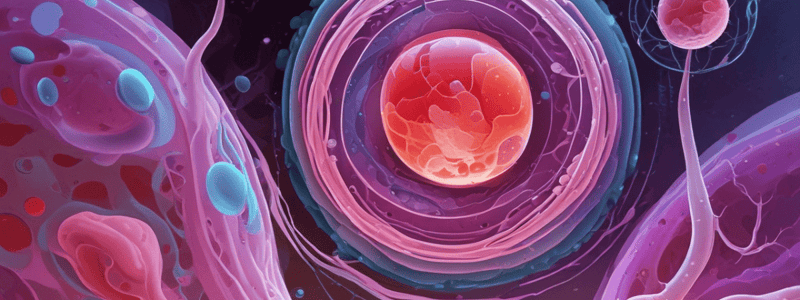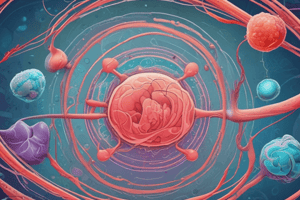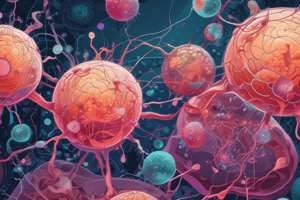Podcast
Questions and Answers
What is the minimum percentage of surface antigens required to meet the ISCT criteria for MSCs?
What is the minimum percentage of surface antigens required to meet the ISCT criteria for MSCs?
- ≥ 99%
- ≥ 100%
- ≥ 95% (correct)
- ≥ 90%
What is a characteristic of Hematopoietic Stem Cells (HSCs)?
What is a characteristic of Hematopoietic Stem Cells (HSCs)?
- High plasticity
- Immune privileged
- High immunogenic
- Multipotent (correct)
Where can Adipose-Derived Stem Cells (ADSCs) be found?
Where can Adipose-Derived Stem Cells (ADSCs) be found?
- In the capillary and adventitia of blood vessels (correct)
- Only in peripheral blood
- Only in umbilical cord blood
- Only in adult bone marrow
What is a characteristic of Umbilical Cord Blood (UCB) cells?
What is a characteristic of Umbilical Cord Blood (UCB) cells?
During embryogenesis, where do HSCs and MSCs migrate to from the yolk sac and aorta-gonad-mesonephros?
During embryogenesis, where do HSCs and MSCs migrate to from the yolk sac and aorta-gonad-mesonephros?
What is the origin of Dental Mesenchymal Stem Cells?
What is the origin of Dental Mesenchymal Stem Cells?
What is a characteristic of Umbilical Cord Blood Mesenchymal Stem Cells (MSCs)?
What is a characteristic of Umbilical Cord Blood Mesenchymal Stem Cells (MSCs)?
What is a feature of Amniotic Fluid Stem Cells?
What is a feature of Amniotic Fluid Stem Cells?
What is a type of dental stem cell?
What is a type of dental stem cell?
What is a characteristic of Cancer Stem Cells?
What is a characteristic of Cancer Stem Cells?
What is the characteristic of embryonic stem cells?
What is the characteristic of embryonic stem cells?
What is the capability of progenitor cells?
What is the capability of progenitor cells?
What is the characteristic of induced pluripotent stem cells (iPSCs)?
What is the characteristic of induced pluripotent stem cells (iPSCs)?
What is the characteristic of multipotent stem cells?
What is the characteristic of multipotent stem cells?
What is the term for the capability of stem cells to differentiate into cells of all three germ layers?
What is the term for the capability of stem cells to differentiate into cells of all three germ layers?
What are the four Yamanaka factors that are highly expressed in ESCs?
What are the four Yamanaka factors that are highly expressed in ESCs?
What is the difference between adult stem cells and embryonic stem cells?
What is the difference between adult stem cells and embryonic stem cells?
What is the primary location of hematopoietic stem cells?
What is the primary location of hematopoietic stem cells?
What is a characteristic of mesenchymal stem cells?
What is a characteristic of mesenchymal stem cells?
What is a function of mesenchymal stem cells?
What is a function of mesenchymal stem cells?
Flashcards are hidden until you start studying
Study Notes
Stem Cells
- Unspecialized cells with the capacity for self-renewal, asymmetric division, and transformation into other mature cell types (potency)
- Classifications:
- Embryonic stem cells (pluripotent, can give rise to all cells in the body)
- Adult stem cells (multipotent, limited to specific cell types)
- Progenitor cells (step between stem cells and specialized cells, capable of differentiation but not self-renewal)
Umbilical Cord Blood Stem Cells
- First isolated from Wharton's jelly
- Mesodermal origin
- Higher proliferative potential and differentiation potential compared to Bone Marrow-MSCs
- Lower number compared to Bone Marrow-MSCs
- Lack of apparent tumorigenicity
- High immunomodulatory activity
- Telomerase activity
Amniotic Fluid Stem Cells
- Likely released from fetal amniotic membrane, embryonic skin, digestive tract, and respiratory and urogenital systems
- Heterogeneous population
- Markers: OCT4, SSEA4, CD29, CD44, CD73, CD90, CD105
- Differentiation into all 3 germ layers
- MSC features
- Potent paracrine effects
- High proliferation rate
- Non-tumorigenic
Stem Cells of Dental Origin
- Locations: 3rd molar, incisors, deciduous
- Origin: Ectomesenchyme, neural crest
- High neural regenerative potential
- Neurotrophic factor secretion
- Types:
- Dental Pulp Stem Cells (DPSC)
- Stem Cells from Human Exfoliated Deciduous Teeth (SHED)
- Stem Cells from Apical Papilla (SCAP)
- Dental follicle stem cells (DFSCs)
- Periodontal ligament stem cells (PDLSCs)
- Gingival fibroblast stem cells (GFSCs)
- Alveolar bone marrow-derived stem cells (ABMSCs)
Cancer Stem Cells
- Tumorigenic
- Component of non-solid and solid tumors
- Solid tumor CSC discovery in glioma (2002)
- Similar characteristics to normal stem cells
- Self-renewal
- Stem cell markers
Embryonic Stem Cells
- Pluripotent
- Derived from the inner cell mass of developing blastocysts
- Self-renewal in-vivo and in-vitro
- Markers: OCT3/4, Nanog, Sox2, SSEA4, TRA1-81, TRA1-60
- Gives rise to cells from all 3 germ layers
- Teratoma formation: capability to differentiate into all three germ layers spontaneously in vivo
- Immortal in vitro
- First isolated by Thomson and Jones in 1998
Induced Pluripotent Stem Cells (iPSCs)
- Genetically modified adult cells to resemble embryonic-like stem cells
- May substitute for ESCs
- Discovered in 2006 by Prof. Yamanaka and Takahashi, Nobel Prize
- Potential for mutagenesis
- Yamanaka factors: Oct4, Sox2, Klf4, c-Myc
- Highly expressed in ESCs
- Developmental signaling network of ESCs
- Determinant of ESC pluripotency
Studying That Suits You
Use AI to generate personalized quizzes and flashcards to suit your learning preferences.




